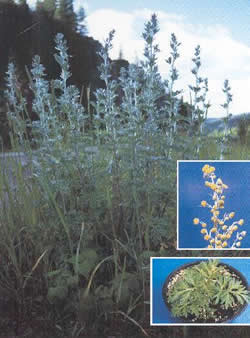
Absinth Wormwood
(Artemisia absinthium L.)
GROWTH HABIT: Erect, perennial, to 4 feet tall.
LEAVES: 1 to 3 inches long, deeply dissected, covered with fine hair, a gray or silver color.
STEMS: Erect, covered with fine hairs.
FLOWER: Small, yellow, in panicles toward top of plant.
ROOTS: Large, woody taproot.
SEEDS: Formed in late summer and fall.
OTHER: Strong medicinal odor, European origin.
(Artemisia absinthium L.)
GROWTH HABIT: Erect, perennial, to 4 feet tall.
LEAVES: 1 to 3 inches long, deeply dissected, covered with fine hair, a gray or silver color.
STEMS: Erect, covered with fine hairs.
FLOWER: Small, yellow, in panicles toward top of plant.
ROOTS: Large, woody taproot.
SEEDS: Formed in late summer and fall.
OTHER: Strong medicinal odor, European origin.
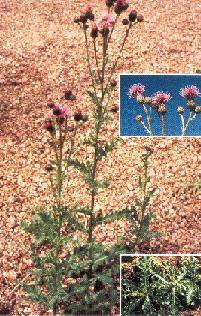
Canadian Thistle
Barnes County uses a variety of chemicals including Tordon, Curtail, and Rodeo to treat Canada Thistle. Canada Thistle is a huge problem for the residents of Barnes County. Because of this we decided to have a test plot for different chemicals applied under different environmental conditions. Chemicals tested were Tordon, 2-4, D, Redeem, Curtail, and Plateau. The test plot is located on Fish and Wildlife land and therefore is comparable to CRP acres in the county. The test plot was first sprayed in the summer of 2001; part was also sprayed in the fall of 2001. Canada Thistle that was left standing, clipped and burned was sprayed. There is a field day planned for the summer of 2002, please watch for information here.
Barnes County uses a variety of chemicals including Tordon, Curtail, and Rodeo to treat Canada Thistle. Canada Thistle is a huge problem for the residents of Barnes County. Because of this we decided to have a test plot for different chemicals applied under different environmental conditions. Chemicals tested were Tordon, 2-4, D, Redeem, Curtail, and Plateau. The test plot is located on Fish and Wildlife land and therefore is comparable to CRP acres in the county. The test plot was first sprayed in the summer of 2001; part was also sprayed in the fall of 2001. Canada Thistle that was left standing, clipped and burned was sprayed. There is a field day planned for the summer of 2002, please watch for information here.
We have started insectaries with five different bio-control agents. Please stay in touch for more information as it becomes available.
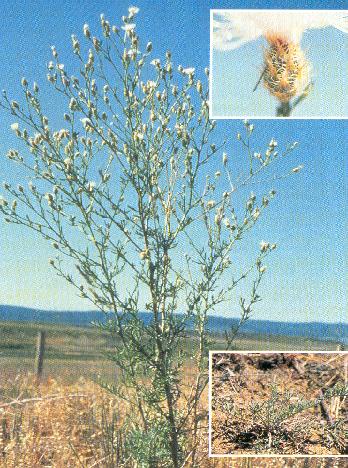
Diffuse Knapweed
(Centaurea diffusa Lam.)
GROWTH HABIT: Annual or biennial, bushy, up to 2 ft. tall. Rosette formed first year, flowering stalk elongates second year.
LEAVES: Grayish-green, alternate, basal leaves whorled, upper leaves much reduced. Covered with fine hair.
STEM: Hairy, erect, single main stem from a rootstock, branched near or above the base.
FLOWER: Solitary, usually white, sometimes pink, rose or lavender; seedhead bracts end as sharp, rigid spines.
ROOTS: Elongated taproot.
SEEDS: Oblong, dark brown or gray with longitudinal lines.
OTHER: May seriously reduce productive potential of infested rangelands.
(Centaurea diffusa Lam.)
GROWTH HABIT: Annual or biennial, bushy, up to 2 ft. tall. Rosette formed first year, flowering stalk elongates second year.
LEAVES: Grayish-green, alternate, basal leaves whorled, upper leaves much reduced. Covered with fine hair.
STEM: Hairy, erect, single main stem from a rootstock, branched near or above the base.
FLOWER: Solitary, usually white, sometimes pink, rose or lavender; seedhead bracts end as sharp, rigid spines.
ROOTS: Elongated taproot.
SEEDS: Oblong, dark brown or gray with longitudinal lines.
OTHER: May seriously reduce productive potential of infested rangelands.
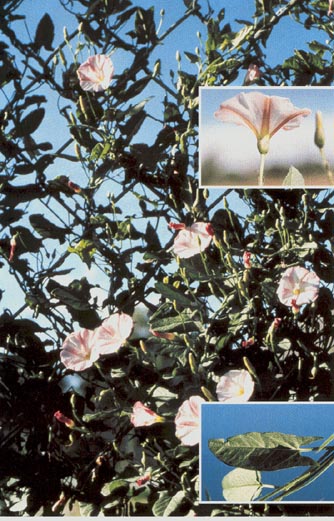
Field Bindweed
(Convolvulus arvensis L.)
GROWTH HABIT: Perennial vine, reproducing from seeds and roots.
LEAVES: Alternate, simple, arrowhead-shaped, rounded or blunt tipped
STEM: Prostrate, twining mat-forming, up to 10 ft. long.
FLOWER: Funnel-shaped, pale pink to white, up to 1 in. wide; two small scale-like bracts attached below flower on flower stem.
ROOTS: Creeping rhizomes, extensive.
SEEDS: Four per capsule, dark gray to reddish brown, three sided.
OTHER: Seeds viable over 60 years. Often confused with wild buckwheat which has heart-shaped sharp pointed leaves and tiny inconspicuous flowers.
(Convolvulus arvensis L.)
GROWTH HABIT: Perennial vine, reproducing from seeds and roots.
LEAVES: Alternate, simple, arrowhead-shaped, rounded or blunt tipped
STEM: Prostrate, twining mat-forming, up to 10 ft. long.
FLOWER: Funnel-shaped, pale pink to white, up to 1 in. wide; two small scale-like bracts attached below flower on flower stem.
ROOTS: Creeping rhizomes, extensive.
SEEDS: Four per capsule, dark gray to reddish brown, three sided.
OTHER: Seeds viable over 60 years. Often confused with wild buckwheat which has heart-shaped sharp pointed leaves and tiny inconspicuous flowers.
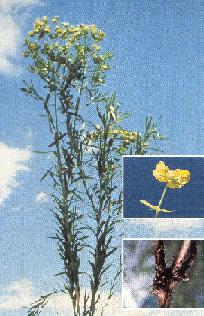
Leafy Spurge
Chemicals used to treat Leafy Spurge include Tordon and Plateau; these are mostly used in roadside ditch spraying and small infestations. Biological control is a large part of control methods used on leafy spurge. We have found that flea beetles are a very effective tool to use and have been very successful in Barnes County. For more information please contact the Weed Control Officer.
Chemicals used to treat Leafy Spurge include Tordon and Plateau; these are mostly used in roadside ditch spraying and small infestations. Biological control is a large part of control methods used on leafy spurge. We have found that flea beetles are a very effective tool to use and have been very successful in Barnes County. For more information please contact the Weed Control Officer.
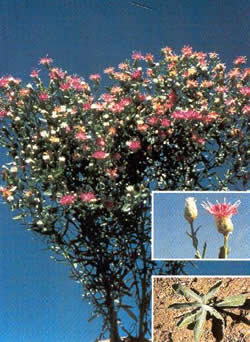
Russian Knapweed
(Centaurea repens L.)
GROWTH HABIT: perennial herb, up to 3 ft. tall, erect, may be in dense clumps. Grayish color.
LEAVES: Alternate, simple, of several types:
Upper leaves - small, narrow, unbroken edge;
Stem leaves -intermediate in size, slight toothed margins;
Basal leaves - deeply notched.
STEMS: Numerous branches, each ending with a single flower.
FLOWER: Single, terminal, lavender, thistle like, scaly seed head.
ROOTS: Dark brown to black and heavily scaled.
SEEDS: Flattened, ivory colored, retained in cup-shaped seed heads.
OTHER: Leaves and stems covered with short stiff hairs giving plant an appearance of knap. Spreads by seeds and creeping rootstocks.
(Centaurea repens L.)
GROWTH HABIT: perennial herb, up to 3 ft. tall, erect, may be in dense clumps. Grayish color.
LEAVES: Alternate, simple, of several types:
Upper leaves - small, narrow, unbroken edge;
Stem leaves -intermediate in size, slight toothed margins;
Basal leaves - deeply notched.
STEMS: Numerous branches, each ending with a single flower.
FLOWER: Single, terminal, lavender, thistle like, scaly seed head.
ROOTS: Dark brown to black and heavily scaled.
SEEDS: Flattened, ivory colored, retained in cup-shaped seed heads.
OTHER: Leaves and stems covered with short stiff hairs giving plant an appearance of knap. Spreads by seeds and creeping rootstocks.
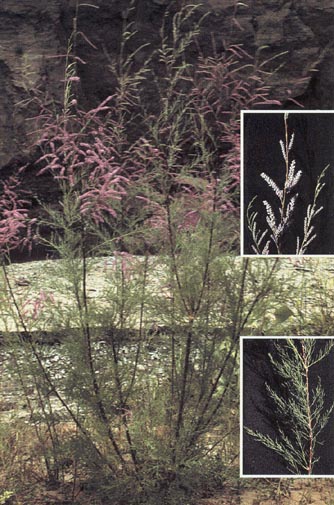
Salt Cedar
(Tamarix ramosissima Ledeb)
GROWTH HABIT: Evergreen Shrub or small tree, up to thirty feet tall, spread by seed.
LEAVES: Small scale like, resemble cedars, salty residue that collects on foliage.
STEM: Numerous, slender, upright and highly branched, smooth reddish brown bark, become furrowed and ridged with age.
FLOWER: Pink to white, five petaled.
ROOTS:Extensive, crown to about 18 inches deep.
SEEDS: 500,000 seeds, small, easily dispersed by wind.
OTHER: Dependent on ground water, areas become dryer with long term occupation.
(Tamarix ramosissima Ledeb)
GROWTH HABIT: Evergreen Shrub or small tree, up to thirty feet tall, spread by seed.
LEAVES: Small scale like, resemble cedars, salty residue that collects on foliage.
STEM: Numerous, slender, upright and highly branched, smooth reddish brown bark, become furrowed and ridged with age.
FLOWER: Pink to white, five petaled.
ROOTS:Extensive, crown to about 18 inches deep.
SEEDS: 500,000 seeds, small, easily dispersed by wind.
OTHER: Dependent on ground water, areas become dryer with long term occupation.
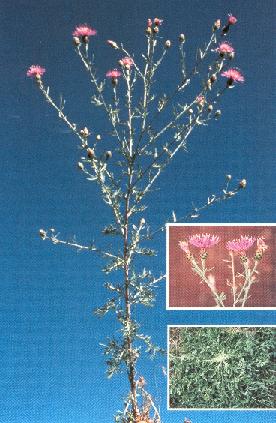
Spotted Knapweed
The only infestation of spotted knapweed in Barnes County that is known is in Sibley Trail Twp. Sec. 2. It presently covers approximately 100 acres. Presently it is being sprayed by plane and the area is closed to all vehicles. All scouting that will be done in the future will be done on foot. Field days take place on a regular basis. Watch for dates and times.
This is a very invasive weed in pastureland and non-cropland and we are very concerned about the spread of spotted knapweed. It is because of this the Barnes County Weed Board is offering a $25 reward for any new sites found in Barnes County and reported to the Weed Control Officer. This is a very invasive weed in pastureland and non-cropland and we are very concerned about the spread of spotted knapweed. It is because of this the Barnes County Weed Board is offering a $25 reward for any new sites found in Barnes County and reported to the Weed Control Officer.
The only infestation of spotted knapweed in Barnes County that is known is in Sibley Trail Twp. Sec. 2. It presently covers approximately 100 acres. Presently it is being sprayed by plane and the area is closed to all vehicles. All scouting that will be done in the future will be done on foot. Field days take place on a regular basis. Watch for dates and times.
This is a very invasive weed in pastureland and non-cropland and we are very concerned about the spread of spotted knapweed. It is because of this the Barnes County Weed Board is offering a $25 reward for any new sites found in Barnes County and reported to the Weed Control Officer. This is a very invasive weed in pastureland and non-cropland and we are very concerned about the spread of spotted knapweed. It is because of this the Barnes County Weed Board is offering a $25 reward for any new sites found in Barnes County and reported to the Weed Control Officer.
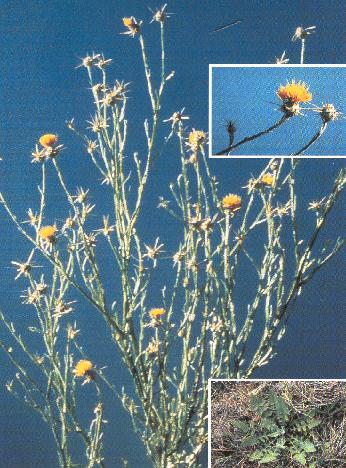
Yellow Starthistle
(Centaurea solstitialis L.)
GROWTH HABIT: Annual, erect, rigid branching stems.
LEAVES: Basal leaves deeply lobed, upper leaves not lobed, small, sharply pointed.
STEMS: Rigid, covered with a cottony fiber, to 30 inches tall, winged structures.
FLOWER: Yellow, terminal, flower bracts are tipped with straw-colored, ¾ inch thorn.
ROOTS: Taproot.
SEEDS: Smooth, light-colored, often darker mottled, 1/8 inch long, notched just above the base.
OTHER: Causes "chewing disease" in horses.
(Centaurea solstitialis L.)
GROWTH HABIT: Annual, erect, rigid branching stems.
LEAVES: Basal leaves deeply lobed, upper leaves not lobed, small, sharply pointed.
STEMS: Rigid, covered with a cottony fiber, to 30 inches tall, winged structures.
FLOWER: Yellow, terminal, flower bracts are tipped with straw-colored, ¾ inch thorn.
ROOTS: Taproot.
SEEDS: Smooth, light-colored, often darker mottled, 1/8 inch long, notched just above the base.
OTHER: Causes "chewing disease" in horses.
Barnes County has other infestations of other noxious weeds, but we feel the ones listed have the most impact on the residence and the environment. All other noxious weeds are being GPS mapped and monitored. We are always looking for new control methods. Please feel free to contact the Weed Control Officer if you have any ideas.